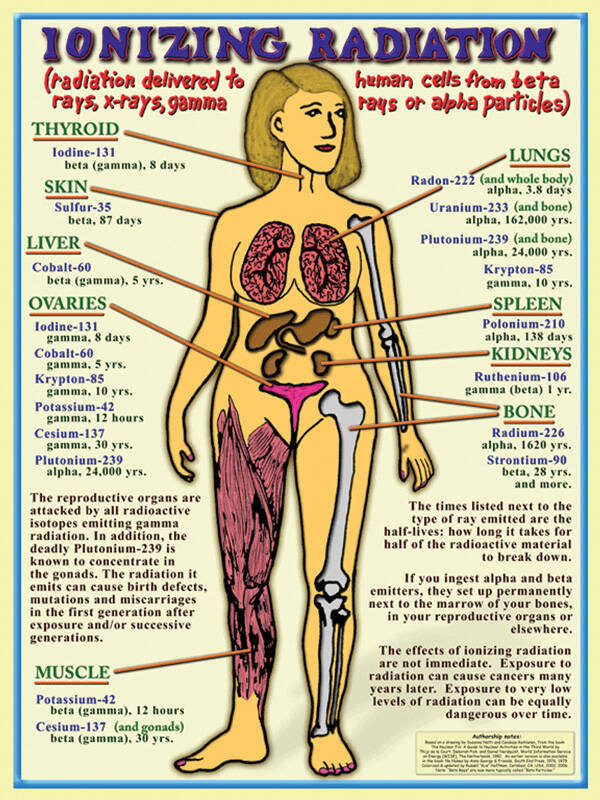Radiation Exposures, Voluntary and Otherwise

There is no safe exposure to ionizing radiation -- the alpha, beta, and gamma and X-rays given off by radioactive materials used in medicine, the military, industry, and nuclear power. The US National Academy of Sciences’ 7th book-length study on the biological effects of ionizing radiation, BEIR-VII, declared that any exposure, regardless of how small, may cause the induction of cancer, birth abnormalities, and/or other diseases. And every US government agency that regulates industrial releases or the medical uses of radiation makes the same warning, based on BEIR-VII.
Today the nuclear military-industrial-medical complex is merely required to keep radiation exposures “As Low As Reasonably Achievable.” I didn’t make that up. This uber-vague, tragi-comic standard is not a medical or scientific concept. It is however the formal admission that radiation’s producers cannot keep worker or public exposures to a level that is safe -- that is to zero.
Exposure standards have been established at the convenience of the vast radiation complex, not by medical doctors or health physicists. During the Cold War arms race, the late Dr. Rosalie Bertell reported in her groundbreaking book No Immediate Danger, “[T]he people with the highest vested interest are the ones that are making the nuclear bombs. And it turns out they have complete control over setting the permissible [radiation exposure] levels. If you were to fix radiation limits at levels that were really protective of human health, you couldn’t get anybody to make bombs.” These corrupt old limits are still mostly in effect today.
What the government has declared an “allowable” dose of ionizing radiation has steadily and dramatically decreased over the years -- as science has come to better understand the toxic, cancer-causing, mutagenic, and teratogenic properties of even low doses.
In the 1920s, the government set the allowable radiation dose for nuclear industry workers at 75 “rem” per year. In 1936 the limit was reduced to 50 rem-per-year; then 20-to-25 in 1948; 15 in 1954, and finally down to five rem-per-year in 1958. This legal dose limit for radiation industry workers is still in effect -- in spite of the fact that the International Commission on Radiation Protection recommended in 1990 that these doses be dramatically reduced (again), from 5-rem, to 2-rem-per-year.
The US just halted its hapless, industry-opposed, 27-year effort to adopt this precautionary standard. (See last week’s column.) Amazingly, the Nuclear Regulatory Commission (NRC) admitted in the Federal Register that implementing the improvement would be too costly, bowing to industry’s lobby efforts rather than adopt a public health standard the rest of the world embraced decades ago.
The general public is officially allowed to be exposed to one-50th of a nuclear industry workers’ radiation dose per year, or 0.1 rem (100 millirem) over a 70-year lifespan. According to research by the Nuclear Information and Resource Service, this allowable, 100 millirem public dose, set by the NRC, imposes a “one of 286” cancer fatality risk standard. That is, fatal cancer given “accidentally” to one out of every 286 people is considered “acceptable,” “permissible” and “allowable” by the federal government. You could call this a license to kill. BEIR-VII found that “radiation at this level to women results in one fatal cancer in every 201 women” -- acknowledging that a given radiation dose is far more dangerous for women than for men, and, by extension, that women’s lives mean less to Uncle Sam than men’s.
The use of radiation in medicine at least involves the patient’s informed consent regarding the risks. And industry workers can be said to voluntarily accept the risks of workplace radiation exposures. But the public’s involuntary and unbeknownst radiation exposures -- via the government’s and industry’s deliberate (and often secret, or misreported, or unregulated, or covered-up) venting, leaking and haphazard dispersal of radioactive gases, liquids and solid wastes -- are adding to cancer statistics that grow worse every year. Radioactive emissions from operating reactors, waste fuel pools, fuel and isotope fabrication facilities, unregulated landfills, waste transports, etc., are avoidable, because the industry can be retired, nuclear weapons abolished, and waste sites cleaned up. Call that a national security objective worthy of the military budget.